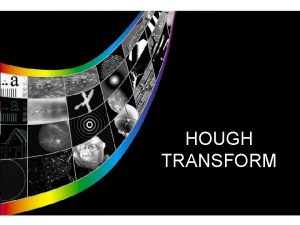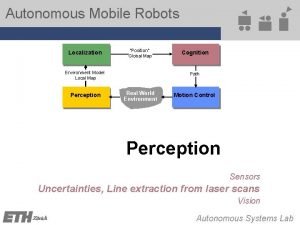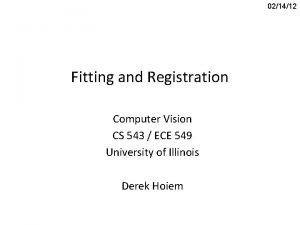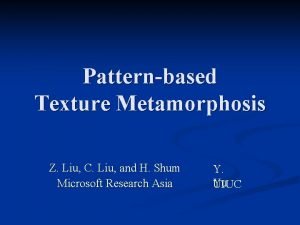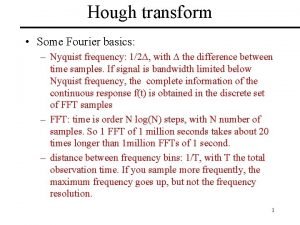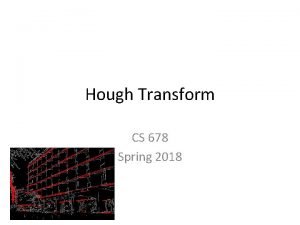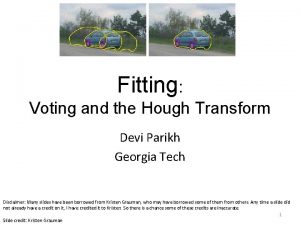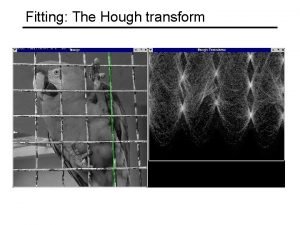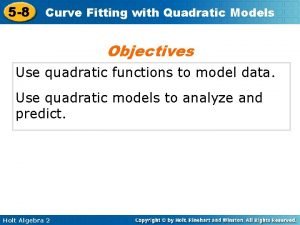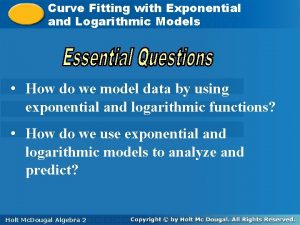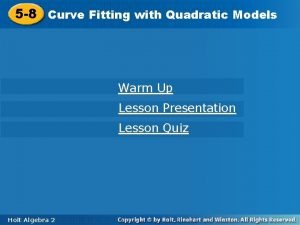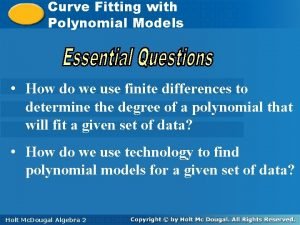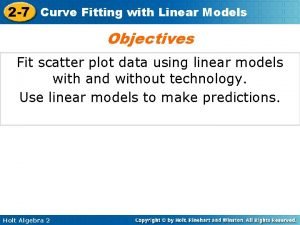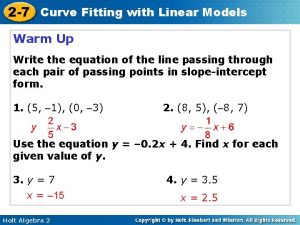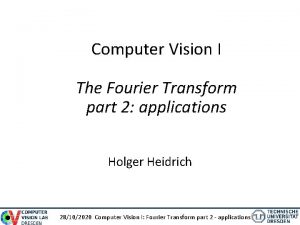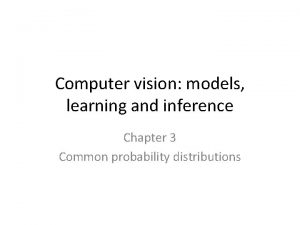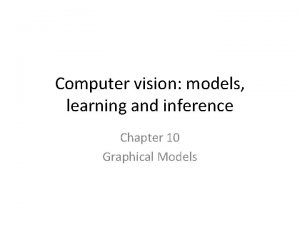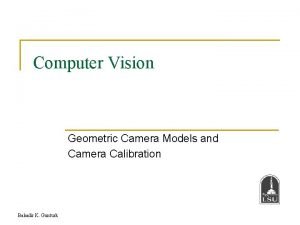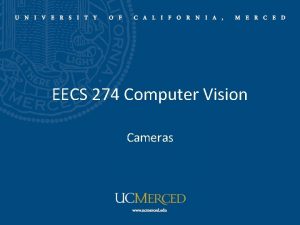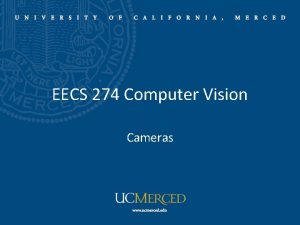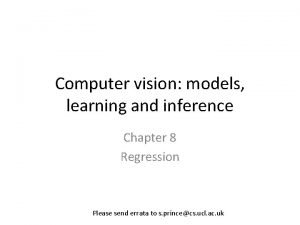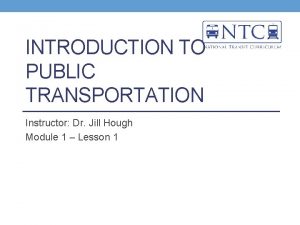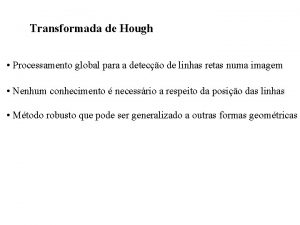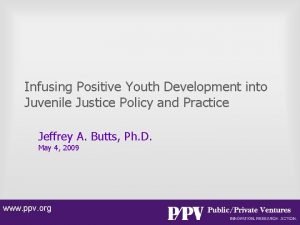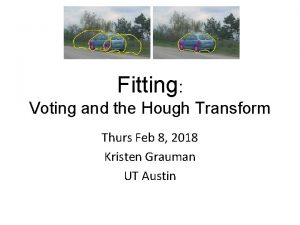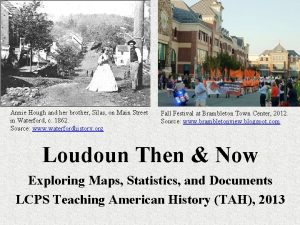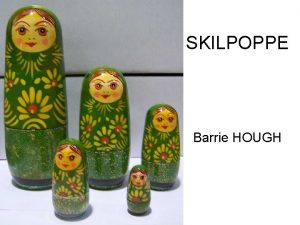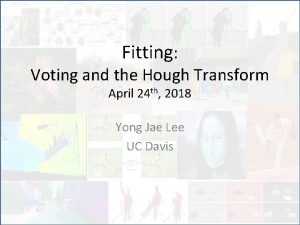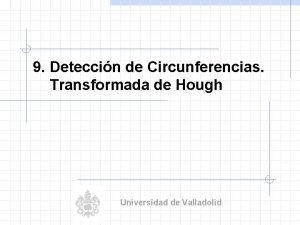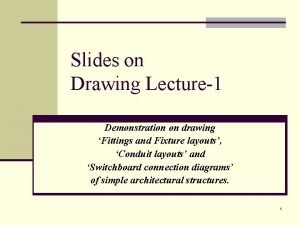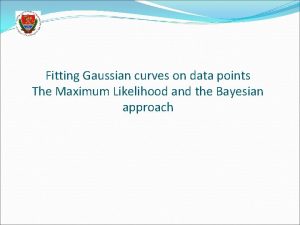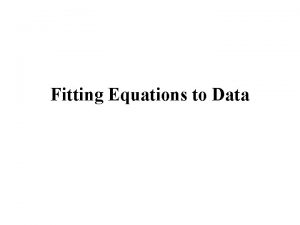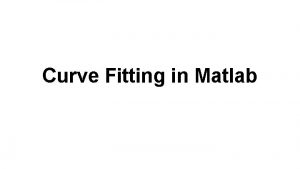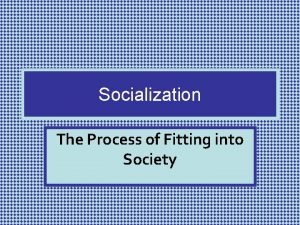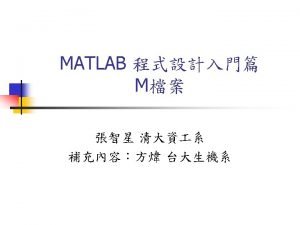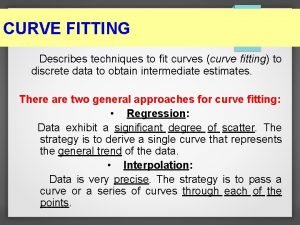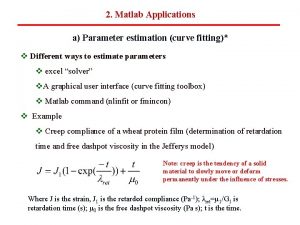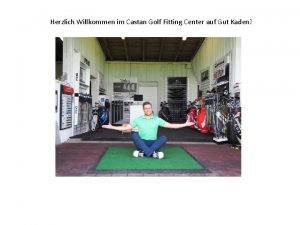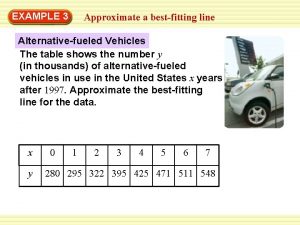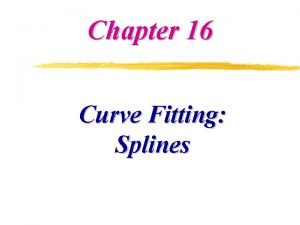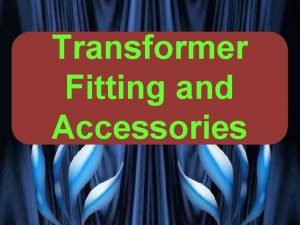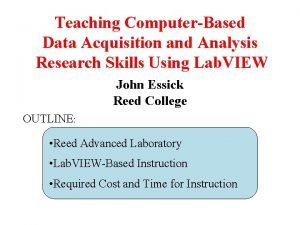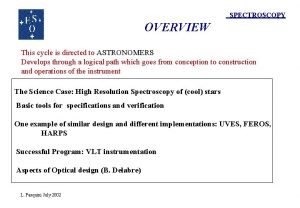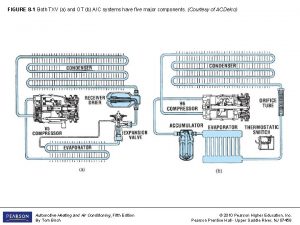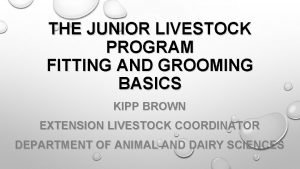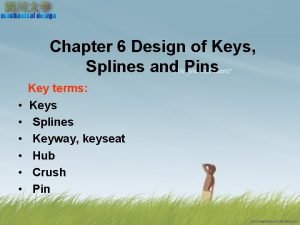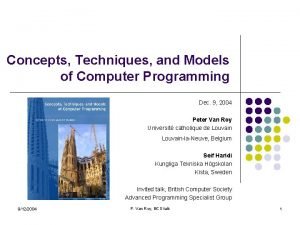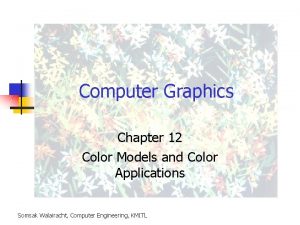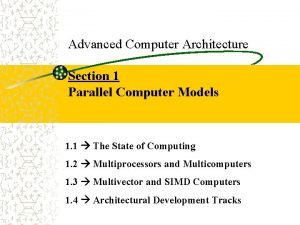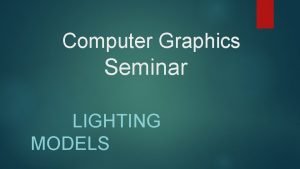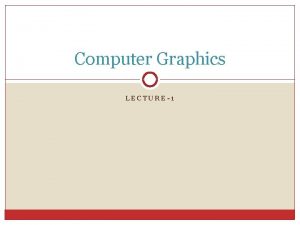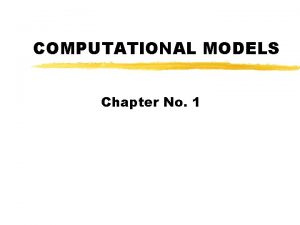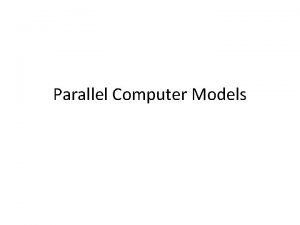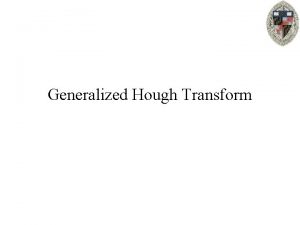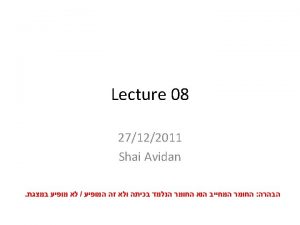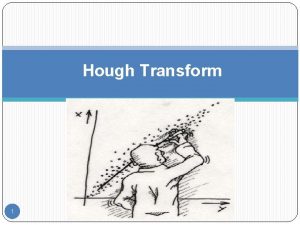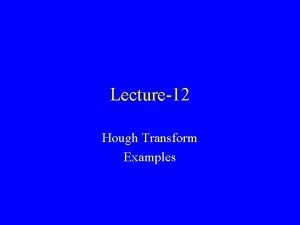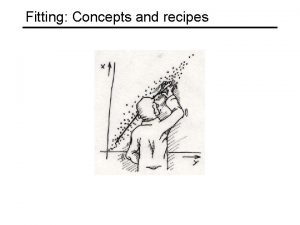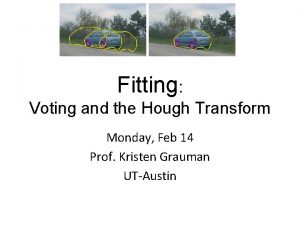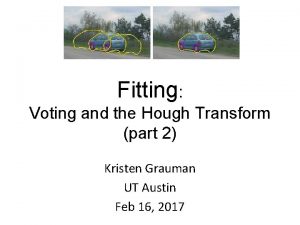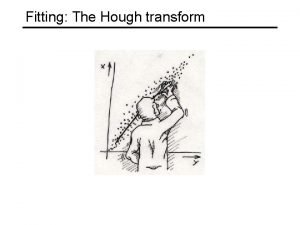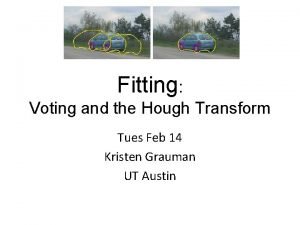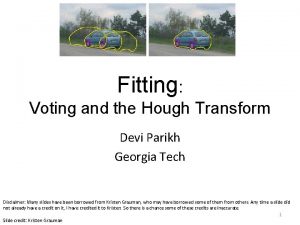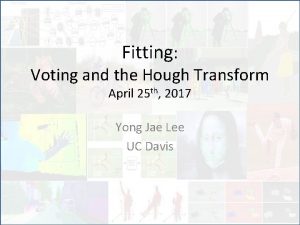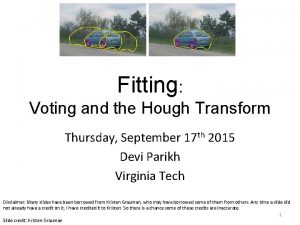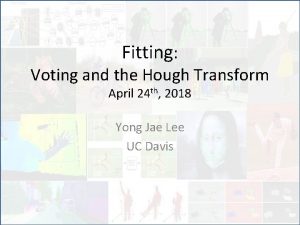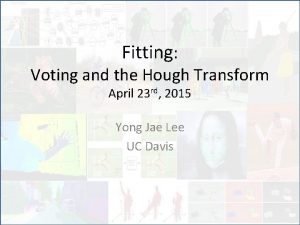CS 2770 Computer Vision Fitting Models Hough Transform
































































- Slides: 64

CS 2770: Computer Vision Fitting Models: Hough Transform & RANSAC Prof. Adriana Kovashka University of Pittsburgh February 28, 2017

Plan for today • Last lecture: Detecting edges • This lecture: Detecting lines (and other shapes) – Find the parameters of a line that best fits our data – Least squares – Hough transform – RANSAC

Characterizing edges • An edge is a place of rapid change in the image intensity function (along horizontal scanline) gradient (first derivative) edges correspond to extrema of gradient Adapted from L. Lazebnik

Canny edge detector • Filter image with derivative of Gaussian • Find magnitude and orientation of gradient • Threshold: Determine which local maxima from filter output are actually edges • Non-maximum suppression: – Thin wide “ridges” down to single pixel width • Linking and thresholding (hysteresis): – Define two thresholds: low and high – Use the high threshold to start edge curves and the low threshold to continue them Adapted from K. Grauman, D. Lowe, L. Fei-Fei

Original image Source: K. Grauman

Thresholding gradient with a higher threshold Source: K. Grauman

Related: Line detection (fitting) • Why fit lines? Many objects characterized by presence of straight lines • Why aren’t we done just by running edge detection? Kristen Grauman

Difficulty of line fitting • Noise in measured edge points, orientations: – e. g. edges not collinear where they should be – how to detect true underlying parameters? • Extra edge points (clutter): – which points go with which line, if any? • Only some parts of each line detected, and some parts are missing: – how to find a line that bridges missing evidence? Adapted from Kristen Grauman

Fitting other objects • Want to associate a model with observed features • The model could be a line, a circle, or an arbitrary shape [Fig from Marszalek & Schmid, 2007] Kristen Grauman

Least squares line fitting • Data: (x 1, y 1), …, (xn, yn) • Line equation: yi = m xi + b y=mx+b (xi, yi) • Find (m, b) to minimize where line you found tells where point really is you point is along y axis Adapted from Svetlana Lazebnik You want to find a single line that “explains” all of the points in your data, but data may be noisy! Matlab: p = A y;

Outliers affect least squares fit Kristen Grauman

Outliers affect least squares fit Kristen Grauman

Outliers • Outliers can hurt the quality of our parameter estimates: – E. g. an edge point that is noise, or doesn’t belong to the line we are fitting • Two common ways to deal with outliers, both boil down to voting: – Hough transform – RANSAC Kristen Grauman

Dealing with outliers: Voting • Voting is a general technique where we let the features vote for all models that are compatible with it. – Cycle through features, cast votes for model parameters. – Look for model parameters that receive a lot of votes. • Noise & clutter features? – They will cast votes too, but typically their votes should be inconsistent with the majority of “good” features. Adapted from Kristen Grauman

Fitting lines: Hough transform • Given points that belong to a line, what is the line? • How many lines are there? • Which points belong to which lines? • Hough Transform is a voting technique that can be used to answer all of these questions. Main idea: 1. Record vote for each possible line on which some edge point lies. 2. Look for lines that get many votes. Kristen Grauman

Finding lines in an image: Hough space y b b 0 x image space m 0 m Hough (parameter) space Connection between image (x, y) and Hough (m, b) spaces • A line in the image corresponds to a point in Hough space Steve Seitz

Finding lines in an image: Hough space y b y 0 x image space m Hough (parameter) space Connection between image (x, y) and Hough (m, b) spaces • A line in the image corresponds to a point in Hough space • What does a point (x 0, y 0) in the image space map to? – Answer: the solutions of b = -x 0 m + y 0 – This is a line in Hough space • To go from image space to Hough space: Adapted from Steve Seitz – given a pair of points (x, y), find all (m, b) such that y = mx + b

Finding lines in an image: Hough space y y 0 b (x 1, y 1) (x 0, y 0) b = –x 1 m + y 1 x 0 x image space m Hough (parameter) space What are the line parameters for the line that contains both (x 0, y 0) and (x 1, y 1)? • It is the intersection of the lines b = –x 0 m + y 0 and b = –x 1 m + y 1 Steve Seitz

Finding lines in an image: Hough space y b x image space m Hough (parameter) space How can we use this to find the most likely parameters (m, b) for the most prominent line in the image space? • Let each edge point in image space vote for a set of possible parameters in Hough space • Accumulate votes in discrete set of bins; parameters with the most votes indicate line in image space. Steve Seitz

Finding lines in an image: Hough space y m b x y m 3 x Adapted from Silvio Savarese 5 3 3 2 2 3 7 11 10 4 3 2 1 1 0 5 3 2 3 4 1 b

Parameter space representation • Problems with the (m, b) space: • Unbounded parameter domains • Vertical lines require infinite m Svetlana Lazebnik

Parameter space representation • Problems with the (m, b) space: • Unbounded parameter domains • Vertical lines require infinite m • Alternative: polar representation Each point (x, y) will add a sinusoid in the ( , ) parameter space Svetlana Lazebnik

Parameter space representation P. V. C. Hough, Machine Analysis of Bubble Chamber Pictures, Proc. Int. Conf. High Energy Accelerators and Instrumentation, 1959 Use a polar representation for the parameter space Each line is a sinusoid in Hough parameter space y x Silvio Savarese Hough space

Algorithm outline • Initialize accumulator H to all zeros • For each edge point (x, y) ρ in the image For θ = 0 to 180 ρ = x cos θ + y sin θ θ H(θ, ρ) = H(θ, ρ) + 1 end • Find the value(s) of (θ*, ρ*) where H(θ, ρ) is a local maximum • The detected line in the image is given by ρ* = x cos θ* + y sin θ* Svetlana Lazebnik

Hough transform example Derek Hoiem http: //ostatic. com/files/images/ss_hough. jpg

Impact of noise on Hough d y x Image space edge coordinates Silvio Savarese Votes

Impact of noise on Hough d y x Image space edge coordinates Votes What difficulty does this present for an implementation? Kristen Grauman

Impact of noise on Hough Noisy data features Need to adjust grid size or smooth Silvio Savarese votes

Impact of noise on Hough Image space edge coordinates Votes Here, everything appears to be “noise”, or random edge points, but we still see peaks in the vote space. Kristen Grauman

Algorithm outline: Let’s simplify • Initialize accumulator H to all zeros • For each edge point (x, y) ρ in the image For θ = 0 to 180 ρ = x cos θ + y sin θ θ H(θ, ρ) = H(θ, ρ) + 1 end • Find the value(s) of (θ*, ρ*) where H(θ, ρ) is a local maximum • The detected line in the image is given by ρ* = x cos θ* + y sin θ* Svetlana Lazebnik

Incorporating image gradients • Recall: when we detect an edge point, we also know its gradient direction • But this means that the line is uniquely determined! • Modified Hough transform: For each edge point (x, y) in the image θ = gradient orientation at (x, y) ρ = x cos θ + y sin θ H(θ, ρ) = H(θ, ρ) + 1 end Svetlana Lazebnik

Hough transform for circles • A circle with radius r and center (a, b) can be described as: x = a + r cos(θ) y = b + r sin(θ) (x, y) (a, b)

Hough transform for circles • Circle: center (a, b) and radius r • For a fixed radius r, unknown gradient direction Image space Kristen Grauman Hough space

Hough transform for circles • Circle: center (a, b) and radius r • For a fixed radius r, unknown gradient direction Intersection: most votes for center occur here. Image space Kristen Grauman Hough space

Hough transform for circles • Circle: center (a, b) and radius r • For an unknown radius r, unknown gradient direction r ? b a Image space Kristen Grauman Hough space

Hough transform for circles • Circle: center (a, b) and radius r • For an unknown radius r, known gradient direction x θ Image space Kristen Grauman Hough space

Hough transform for circles x = a + r cos(θ) y = b + r sin(θ) For every edge pixel (x, y) : For each possible radius value r: For each possible gradient direction θ: // or use estimated gradient at (x, y) a = x – r cos(θ) // column b = y – r sin(θ) // row H[a, b, r] += 1 end θ end x Modified from Kristen Grauman

Example: detecting circles with Hough Original Edges Votes: Penny Note: a different Hough transform (with separate accumulators) wa used for each circle radius (quarters vs. penny). Kristen Grauman, images from Vivek Kwatra

Example: detecting circles with Hough Original Combined detections Edges Votes: Quarter Note: a different Hough transform (with separate accumulators) wa used for each circle radius (quarters vs. penny). Kristen Grauman, images from Vivek Kwatra

Example: iris detection Gradient+threshold Kristen Grauman Hough space (fixed radius) Max detections Hemerson Pistori and Eduardo Rocha Costa http: //rsbweb. nih. gov/ij/plugins/hough-circles. html

Voting: practical tips • Minimize irrelevant tokens first (reduce noise) • Choose a good grid / discretization Too fine ? Too coarse – Too coarse: large votes obtained when too many different lines correspond to a single bucket – Too fine: miss lines because points that are not exactly collinear cast votes for different buckets • Vote for neighbors, also (smoothing in accumulator array) • Use direction of edge to reduce parameters by 1 • To read back which points voted for “winning” peaks, keep tags on the votes Kristen Grauman

Generalized Hough transform • We want to find a template defined by its reference point (center) and several distinct types of landmark points in stable spatial configuration Template c Adapted from Svetlana Lazebnik Triangle, circle, diamond: some type of visual token, e. g. feature or edge point

Generalized Hough transform Intuition: Displacement vectors x xx Ref. point Model image x Novel image x Vote space Now suppose those colors encode gradient directions… Adapted from Kristen Grauman

Generalized Hough transform Define a model shape by its boundary points and a reference point. Offline procedure: x θ a θ p 2 p 1 Model shape … θ θ … At each boundary point, compute displacement vector: r = a – pi. Store these vectors in a table indexed by gradient orientation θ. … Kristen Grauman [Dana H. Ballard, Generalizing the Hough Transform to Detect Arbitrary Shapes, 1980]

Generalized Hough transform (quickly) Detection procedure: x For each edge point: • Use its gradient orientation θ to index into stored table • Use retrieved r vectors to vote for reference point … θ θ … Kristen Grauman … xx θ θ p 1 θ θ Novel image Assuming translation is the only transformation here, i. e. , orientation and scale are fixed.

Generalized Hough transform • Template representation: for each type of landmark point, store all possible displacement vectors towards the center Template Svetlana Lazebnik Model

Generalized Hough transform • Detecting the template: • For each feature in a new image, look up that feature type in the model and vote for the possible center locations associated with that type in the model Test image Svetlana Lazebnik Model

Preview: Hough for object detection • Index displacements by “visual codeword” with displacement vectors training image B. Leibe, A. Leonardis, and B. Schiele, Combined Object Categorization and Segmentation with an Implicit Shape Model, ECCV Workshop on Statistical Learning in Computer Vision 2004 Svetlana Lazebnik

Hough transform: pros and cons Pros • All points are processed independently, so can cope with occlusion, gaps • Some robustness to noise: noise points unlikely to contribute consistently to any single bin • Can detect multiple instances of a model in a single pass Cons • Complexity of search time for maxima increases exponentially with the number of model parameters – If 3 parameters and 10 choices for each, search is O(103) • Non-target shapes can produce spurious peaks in parameter space • Quantization: can be tricky to pick a good grid size Adapted from Kristen Grauman

RANSAC • RANdom Sample Consensus • Approach: we want to avoid the impact of outliers, so let’s look for “inliers”, and use those only. • Intuition: if an outlier is chosen to compute the current fit, then the resulting line won’t have much support from rest of the points. Kristen Grauman

RANSAC: General form • RANSAC loop: 1. Randomly select a seed group of s points on which to base model estimate (e. g. s=2 for a line) 2. Fit model to these s points 3. Find inliers to this model (i. e. , points whose distance from the line is less than t) 4. Repeat N times • Keep the model with the largest number of inliers Adapted from Kristen Grauman and Svetlana Lazebnik

RANSAC (RANdom SAmple Consensus) : Fischler & Bolles in ‘ 81. Line fitting example Algorithm: 1. Sample (randomly) the number of points required to fit the model 2. Solve for model parameters using samples 3. Score by the fraction of inliers within a preset threshold of the model Repeat 1 -3 until the best model is found with high confidence Silvio Savarese

RANSAC (RANdom SAmple Consensus) : Fischler & Bolles in ‘ 81. Line fitting example Algorithm: 1. Sample (randomly) the number of points required to fit the model (#=2) 2. Solve for model parameters using samples 3. Score by the fraction of inliers within a preset threshold of the model Repeat 1 -3 until the best model is found with high confidence Silvio Savarese

RANSAC (RANdom SAmple Consensus) : Fischler & Bolles in ‘ 81. Line fitting example Algorithm: 1. Sample (randomly) the number of points required to fit the model (#=2) 2. Solve for model parameters using samples 3. Score by the fraction of inliers within a preset threshold of the model Repeat 1 -3 until the best model is found with high confidence Silvio Savarese

RANSAC (RANdom SAmple Consensus) : Fischler & Bolles in ‘ 81. Line fitting example Algorithm: 1. Sample (randomly) the number of points required to fit the model (#=2) 2. Solve for model parameters using samples 3. Score by the fraction of inliers within a preset threshold of the model Repeat 1 -3 until the best model is found with high confidence Silvio Savarese

RANSAC (RANdom SAmple Consensus) : Fischler & Bolles in ‘ 81. Line fitting example Algorithm: 1. Sample (randomly) the number of points required to fit the model (#=2) 2. Solve for model parameters using samples 3. Score by the fraction of inliers within a preset threshold of the model Repeat 1 -3 until the best model is found with high confidence Silvio Savarese

How to choose parameters? • Number of samples N – Choose N so that, with probability p, at least one random sample is free from outliers (e. g. p=0. 99) (outlier ratio: e ) • Number of sampled points s – Minimum number needed to fit the model • Distance threshold – Choose so that a good point with noise is likely (e. g. , prob=0. 95) within threshold – E. g. for zero-mean Gaussian noise with std. dev. σ: 2 = 3. 84σ2 proportion of outliers e Explanation in Szeliski 6. 1. 4 Marc Pollefeys and Derek Hoiem s 2 3 4 5 6 7 8 5% 2 3 3 4 4 4 5 10% 3 4 5 6 7 8 9 20% 25% 30% 40% 5 6 7 11 17 7 9 11 19 35 9 13 17 34 72 12 17 26 57 146 16 24 37 97 293 20 33 54 163 588 26 44 78 272 1177

RANSAC pros and cons • Pros • Applicable to many different problems • Often works well in practice • Cons • Lots of parameters to tune (see previous slide) • Doesn’t work well for low inlier ratios (too many iterations, or can fail completely) • Common applications • Image stitching, relating two views • Spatial verification Adapted from Svetlana Lazebnik

Application: Keypoint match for search In database Query B 3 A 1 A 2 1. Find a set of distinctive keypoints A 3 B 2 B 1 2. Define a region around each keypoint (window) 3. Compute a local descriptor from the region 4. Match descriptors Adapted from K. Grauman, B. Leibe

Example: solving for translation A 1 A 2 A 3 B 1 B 2 B 3 Given matched points in {A} and {B}, estimate the translation of the object Derek Hoiem

Example: solving for translation A 1 A 2 A 3 (tx, ty) B 1 B 2 Least squares solution 1. Write down objective function in form Ax=b 2. Solve e. g. using pseudo-inverse Adapted from Derek Hoiem B 3

Example: solving for translation A 1 A 2 A 5 B 4 A 3 (tx, ty) A 4 B 1 B 2 B 5 Problem: outliers RANSAC solution 1. Sample a set of matching points (1 pair) 2. Solve for transformation parameters 3. Repeat N times Adapted from Derek Hoiem B 3

Example: solving for translation B 4 A 1 A 2 B 5 B 6 (tx, ty) A 3 B 2 A 4 A 5 A 6 Problem: outliers, multiple objects Hough transform solution 1. Initialize a grid of parameter values 2. Each matched pair casts a vote for consistent values 3. Find the parameters with the most votes Adapted from Derek Hoiem B 1 B 3

Fitting and Matching: Summary • Fitting problems require finding any supporting evidence for a model, even within clutter and missing features. • Voting and inlier approaches, such as the Hough transform and RANSAC, make it possible to find likely model parameters without searching all combinations of features, and with decreased impact from outliers. • Can use these approaches to compute robust feature alignment/matching, and to match object templates. Adapted from Kristen Grauman and Derek Hoiem
 Hough transform
Hough transform Hough transform
Hough transform Cs 543
Cs 543 Generalized hough transform
Generalized hough transform Hough transform
Hough transform Hough transform
Hough transform Hough transform
Hough transform Hough
Hough Quadratic curve fitting
Quadratic curve fitting Logarithmic curve fitting
Logarithmic curve fitting Curve fitting with quadratic models
Curve fitting with quadratic models Curve fitting with polynomial models
Curve fitting with polynomial models Curve fitting with linear models
Curve fitting with linear models Curve fitting with linear models
Curve fitting with linear models Fourier transform computer vision
Fourier transform computer vision Computer vision models learning and inference
Computer vision models learning and inference Computer vision: models, learning, and inference
Computer vision: models, learning, and inference Computer vision: models, learning, and inference pdf
Computer vision: models, learning, and inference pdf Coordinate rotation matrix
Coordinate rotation matrix Camera models in computer vision
Camera models in computer vision Camera models in computer vision
Camera models in computer vision Computer vision: models, learning, and inference
Computer vision: models, learning, and inference Structured light
Structured light Jill hough
Jill hough Transformada de hough
Transformada de hough Bruce robert hough
Bruce robert hough Hough voting
Hough voting Annie hough
Annie hough Emily hough nhs
Emily hough nhs Cleveland hough riots
Cleveland hough riots Skilpoppe barrie hough
Skilpoppe barrie hough Hough voting
Hough voting Transformada de hough
Transformada de hough Hough raum
Hough raum Modals and semi-modals
Modals and semi-modals Fitting and fixture layout
Fitting and fixture layout Wwglass
Wwglass Gaussian curve fitting
Gaussian curve fitting Fitting equations to data
Fitting equations to data Curve fitting matlab
Curve fitting matlab Fitting into society
Fitting into society Matlab
Matlab Curve fitting techniques
Curve fitting techniques Parameter estimation matlab
Parameter estimation matlab Castan golf fitting
Castan golf fitting How to approximate the best fitting line for data
How to approximate the best fitting line for data Dr comfort return form
Dr comfort return form Butler system heat exchanger
Butler system heat exchanger Quadratic spline matlab
Quadratic spline matlab Transformer fittings and accessories
Transformer fittings and accessories Labview curve fitting
Labview curve fitting Primordial nucleosynthesis
Primordial nucleosynthesis A/c fitting size chart
A/c fitting size chart Steer clipping and fitting techniques
Steer clipping and fitting techniques Spline shaft design
Spline shaft design Concepts, techniques and models of computer programming
Concepts, techniques and models of computer programming Hls color model
Hls color model Parallel computer models
Parallel computer models Lighting models in computer graphics
Lighting models in computer graphics Computer graphics models are now commonly used for making
Computer graphics models are now commonly used for making Computational model in computer architecture
Computational model in computer architecture Four special cases in linear programming
Four special cases in linear programming One crore in number
One crore in number 16385 cmu
16385 cmu Kalman filter computer vision
Kalman filter computer vision
